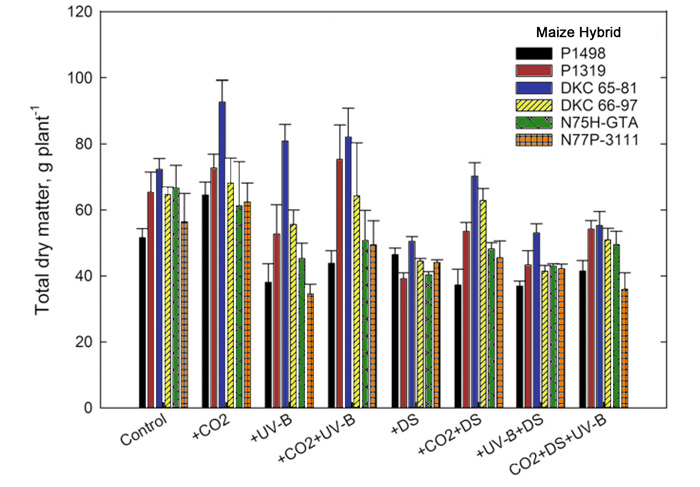| Follow @co2science |
Paper Reviewed
Wijewardana, C., Henry, W.B., Gao, W. and Reddy, K.R. 2016. Interactive effects of CO2, drought, and ultraviolet-B radiation on maize growth and development. Journal of Photochemistry & Photobiology, B: Biology 160: 198-209.
Introducing their important new work, Wijewardana et al. (2016) write that maize (Zea mays) "is the third most important agricultural crop globally in terms of production and its demand is predicted to increase by 45% from 1997-2020 (Rosegrant et al., 2001)." In light of such demand for growth, the team of four researchers rightly note that "substantial adaptation of maize [is] needed to ensure an adequate supply for the growing demand of food, biofuels and other industry needs."
So how is this to be done?
Answering this critical question, Wijewardana et al. say that commercial maize hybrids must be screened to determine the potential for improvements in new maize hybrids to meet the challenges of future breeding target environments, which challenges might include increased water stress, hotter temperatures, or greater UV-B radiation. And with that recognition, the four researchers embarked on a study to begin just such a screening. More specifically, they investigated the growth response of six maize hybrids to drought, UV-B radiation and carbon dioxide (CO2).
The maize hybrids were grown in sunlit Soil-Plant-Atmosphere-Research chambers at the R.R. Foil Plant Science Research facility at Mississippi State University, MS, USA. Treatment conditions included two levels of CO2 (400 and 800 ppm), two levels of water stress (100 and 50% irrigation treatment based on evapotranspiration measurements) and two levels of biologically effective UV-B radiation intensities (0 and 10 kJ m-2 d-1). A number of growth-related measurements were made throughout the course of the experiment, which ended 38 days after planting. And what did those measurements reveal?
Compared with ambient conditions, alone or in combination with water and/or UV-B stress, elevated CO2 significantly increased maize hybrid plant height, leaf number and leaf area, though the magnitudes of the responses varied by hybrid. With respect to total plant dry matter, elevated CO2 stimulated this important parameter as well. Averaged across the six hybrids, based upon data presented in the figure below, elevated CO2 induced an average 13 percent increase in dry matter under adequate water and normal UV-B conditions, a 19 percent increase under UV-B stressed conditions, a 20 percent increase when water stressed and a 10 percent increase under combined water and UV-B stressed conditions. Thus, although drought and UV-B stress had negative effects on maize hybrid growth, as stated by Wijewardana et al., elevated CO2 "caused a positive increase in both vegetative and physiological traits."

Figure 1. Impact of CO2 concentration (control, 400 ppm and +CO2, 750 ppm), drought stress (control, 100% irrigation treatment based on evapotranspiration measurements and DS, 50% irrigation treatment based on evapotranspiration measurements), and UV-B radiation (control, 0 and +UV-B, 10 kJ m-2 d-1), and their interactions on total plant dry matter for six maize hybrids (P1498, DKC 65-81, N75H-GTA, P1319, DKC 66-97, and N77P-3111). Bars indicate standard errors of the mean ± 5 replications. Adapted from Wijewardana et al. (2016).
In commenting on their findings, Wijewardana et al. state that the variation in response for these commercially available maize hybrids analyzed in their study "suggests that genotypic variation exists and could be selected to optimize stress tolerance in future hybrid construction." And the more that scientists identify those genotypes most responsive to elevated CO2 and least affected by environmental stresses, and the more that farmers grow them, the more likely society will be able to meet the growing maize demand in the coming years and decades.
Reference
Rosegrant, M.W., Paisner, M.S., Meijer, S. and Witcover, J. 2001. Global Food Projections to 2020: Emerging Trends and Alternative Futures. International Food Policy Research Institute,Washington, D.C.




